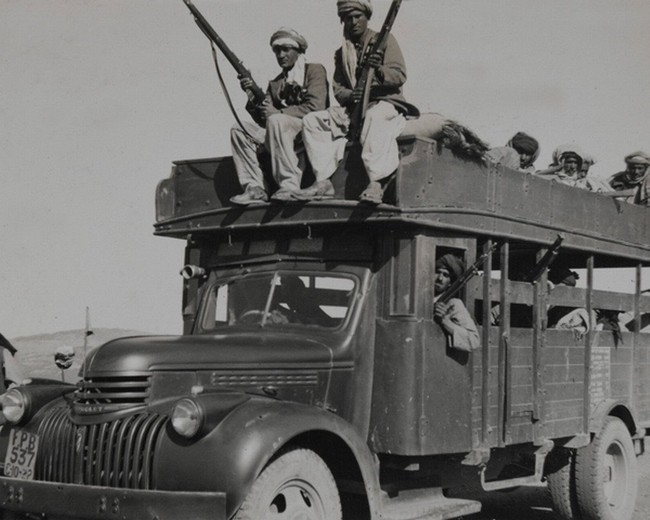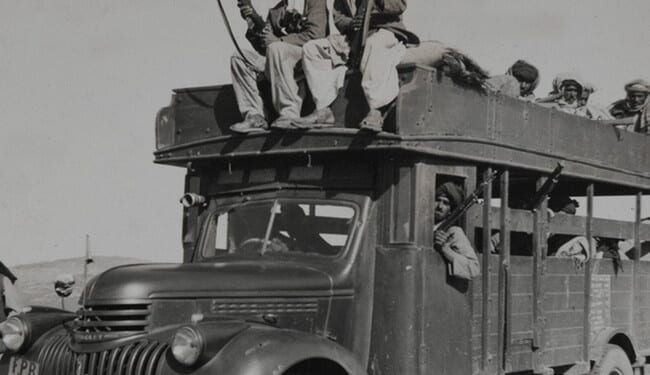
Until the fourteenth century, when Islamic invaders took over Southeast Asia, historical Kashmir had a majority Hindu population but was also inhabited by Buddhists. Hindus indigenous to the Kashmir Valley are known as Kashmiri Hindu Pandits; they are the original inhabitants of Kashmir. They have a unique ethno-religious culture that dates back more than 5,000 years.
The Union Territory of Jammu and Kashmir (J&K) is an integral part of India from time immemorial. It has continued in this role since its formal accession into the Indian Union after decolonization in 1947. Yet Pakistan occupies 30,159 square miles of Kashmir, and that part of the region (also known as Pakistan-occupied Kashmir/PoK) currently has no Hindu or other non-Muslim population. How did this happen?
The history of the Islamization of the Pakistan-occupied Kashmir (PoK) teaches many lessons regarding how demographics, culture, and political landscapes have changed as a result of Islamic invasions, mass murders, expulsions, and forced conversions.
Foreign Muslim armies started targeting Kashmir in the eighth century – a process that continued for centuries. Following waves of Islamic invasions, numerous foreign Muslim rulers of foreign origin occupied Kashmir until 1819. Under Muslim rule, Hindus faced periods of persecution that resulted in several mass migrations from Kashmir. Sikhs gained control over the region in 1819 and ruled there until 1846. The Hindu Dogra, an ethnic group native to the Jammu region in the state, reigned from 1846 to 1947.
The 22 October 1947 invasion of Jammu and Kashmir (J&K) by Pakistan was a turning point in the region’s history.
The Princely State of Kashmir was ruled by the Dogra king Hari Singh, the Maharaja (Prince) of Kashmir, at the time of India’s 1947 partition. It joined the Indian Union after Pakistan’s Armed Forces orchestrated an invasion of Kashmir using Pashtun tribesmen and regular military personnel. The invading tribal militia committed mass atrocities against the people of Kashmir. These atrocities included massacres of Muslims and Hindus, as well as the capture of non-Muslim women.
October 22 is commemorated as a “Black Day” in India. It is meant to express condemnation for the violence and displacement started by Pakistan in J&K. It was Pakistan’s first armed attempt to seize and occupy J&K, which continues to this day. Thousands of Hindus and Sikhs were forced to flee PoK, while thousands more were murdered.
Initially, both India and Pakistan had accepted the J&K offer of a standstill agreement. But on 24 August 1947, Pakistan threatened the Maharaja that “should Kashmir fail to join Pakistan, the gravest possible trouble will inevitably ensue.” Within two months, Pakistan executed this threat and attacked Jammu & Kashmir (J &K) on October 22.
The invasion was meticulously planned by the Pakistani army (codenamed “Operation Gulmarg”). The government of Pakistan feared that the Maharaja might accede to India; hence, Pakistan gave support to the operation.
There has been extensive proof of both the Pakistan army and government encouraging tribal communities to target Hindus and other non-Muslims.
The operation was masqueraded as raids by tribal invaders (people’s rebellion against the Maharaja). Pakistan Major General Akbar Khan’s book (the then Director of Weapons and Equipment at Army Headquarters) gives a detailed account of the planning and direct involvement of the Pakistani army.
Military grade weapons like the Star Augustine rifles were used by the army’s Special Service Group (SSG) found among captured militants. Numerous eyewitnesses and foreign authors, amongst others, have proven the involvement of the Pakistan army in the invasion. Moreover, the way it was conceptualized, organized, and executed clearly indicates the involvement of Pakistan’s army.
Major General Akbar Khan was codenamed General Tariq, and Brigadier Sher Khan assisted him. Sardar Shaukat Hayat Khan, a close confidant of Mohammad Ali Jinnah, wrote in his book that “The nation that lost its soul.” He confessed that he played an important role in planning, leading, and financing the operation. He also reports that Ghulam Muhammad, who was the Finance Minister, had given three hundred thousand rupees from the treasury.
The operation involved Pashtun tribes of the North-West Frontier Province (NWFP). It is estimated that at least 1000 tribesmen were mixed with Pakistani army regulars. Shuza Nawaz, Distinguished Fellow of the South Asia Center at the Atlantic Council in Washington, D.C., has identified 22 Pashtun tribes involved in the invasion. They gathered at Banu, Wana, Peshawar, Kohat, Thal, and Nowshera, where the Pakistani army Brigade commanders gave them arms and ammunition.
On October 22, the battle of Muzaffarabad was fought between a mixed force of Pakistan-backed Pashtun tribesmen and Pakistani army regulars on one side against the forces of the Maharaja of Kashmir (J&K State Forces).
Larry Collins and Dominique Lapierre, in their book “Freedom at Midnight,” highlighted the capture of Muzaffarabad by the Pushtun tribesmen, who began to exterminate and slaughter the non-Muslim population.
Pakistani journalist Zahid Chaudhay also chronicled the horrors that unfolded in Muzaffarabad in his 12-volume work “Pakistan ki Siyasi Tarikh.” According to him, Major Khurshid Anwar encouraged the invaders to wreak havoc on non-Muslim men and women for three days. Eyewitnesses like Khawaja Abdul Samad explained the ordeal. About 5000 Hindus, Sikhs, and Kashmiri Muslims were killed. It is further estimated that 1,600 women were kidnapped.
The Pakistani army then directed the marauding Lashkars to Mirpur-Uri- Baramullah. They created mayhem with murders, rapes, and plunder along the way. In Baramullah, they looted and plundered for three days. On November 25, 1947, over 20,000 Hindus and Sikhs were slaughtered by the invaders in the city of Mirpur in what became known as the Mirpur Massacre.
Rev. Father Shanks, Principal of St. Joseph’s Degree College in Baramullah, was in a hospital where he witnessed the brutal murder of a nurse, two religious figures, Col. Dykes, and his wife. About eleven thousand residents were killed, and the Mohra power station that supplied electricity to Srinagar was destroyed.
In total, about 35,000 to 40,000 people were killed in J&K by the invading Pakistan army, whom the Lashkars backed.
Following the loot and mayhem, the Maharaja of Kashmir signed the Instrument of Accession to India (October 26, 1947), leading to a decision from India to airlift troops in defense of the state.
On October 27, 1947, the first infantry contingent of the Indian army landed at Srinagar Airfield. Srinagar was defended in the decisive battle of Shalteng. Brigadier L.P. Sen recaptured Baramullah on November 8, and later, they captured Uri and Poonch. In the next few months, the Indian army drove the intruders out from most of the portions except for today’s Pakistan-occupied Kashmir (PoK).
The October 22, 1947, invasion was a tragedy for the entire South Asia region. It was the first massive blow to the Kashmiriyat, a philosophy of religious inclusiveness and deep emotional empathy. This philosophy is a way of life that has prevailed in J&K since time immemorial.
The UN Security Council passed Resolution 47, which required Pakistan to first withdraw all of its military personnel and tribesmen from Kashmir as a necessary precondition to holding a plebiscite. In August 1948, however, the UN Commission on India and Pakistan (UNCIP) found that Pakistan had instead increased its military presence.
Kashmir’s invasion by Pakistan eventually led to a UN-mediated ceasefire on January 1, 1949. Following the ceasefire, Pakistan remained in control of approximately one-third of the state while the remaining two-thirds were incorporated into India under Article 370 of India’s Constitution. Along with Article 35A, this change defined residential and property rights by granting a special status to the state.
During the 1947 invasion of Kashmir by Pakistan, the barbaric loot and pillage shocked the world, changing the geography and culture of Kashmir. It marked the beginning of Pakistani-sponsored terrorism in J&K, a situation which continues to this day. The recent Pahalgam terror attack carried out by Lashkar-e-Taiba (LeT), a Pakistan-based internationally designated terror group, was yet another bloody chapter of this terrorism.
Military historian, Major Agha Humayun Amin, in his book, “The 1947-48 Kashmir War: The War of Lost Opportunities,” has written that the Pakistani policy of using non-state actors as state proxies was repeated in 1965, in Kashmir from 1988-2003, and during the 1999 Kargil War. Even today, after repeated failures, Pakistan continues to believe in the same strategy and adopts the same methods.
Today, people in PoK are living in miserable conditions, deprived of basic human rights. They face state excesses, power shortages, and terror attacks. On the other hand, the Indian side of J&K has five times more expenditure on infrastructure development and double the per capita income when compared to their counterparts in Pakistan-occupied Kashmir (PoK).
Since the abrogation of Article 370 in 2019, the development of J&K has gathered renewed pace, while, as evidenced by the recent mass protest in PoK, the situation in Pakistan remains grim.
Editor’s Note: The Schumer Shutdown is here. Rather than put the American people first, Chuck Schumer and the radical Democrats forced a government shutdown for healthcare for illegals. They own this. Help us continue to report the truth about the Schumer Shutdown. Use promo code POTUS47 to get 74% off your VIP membership.








